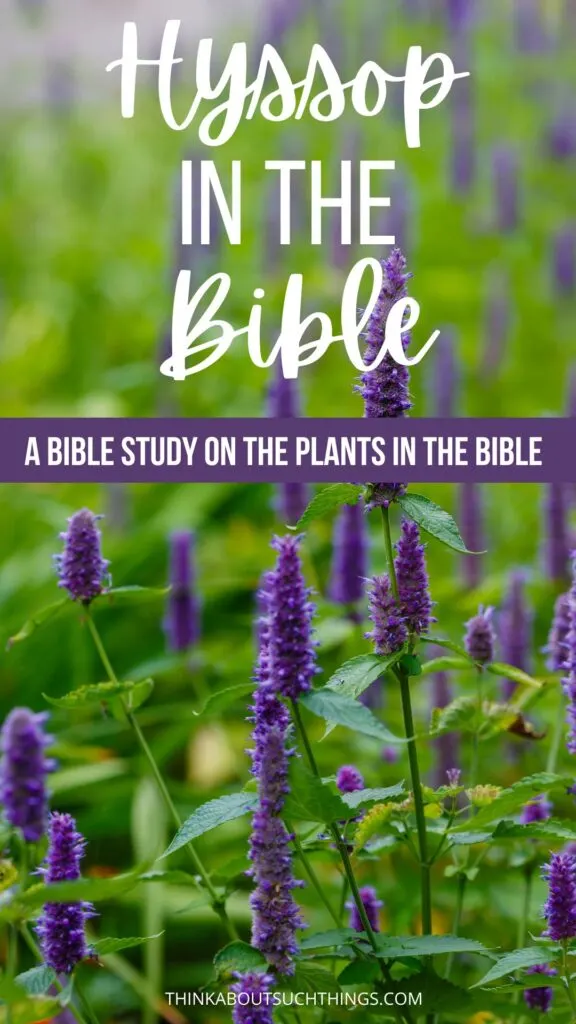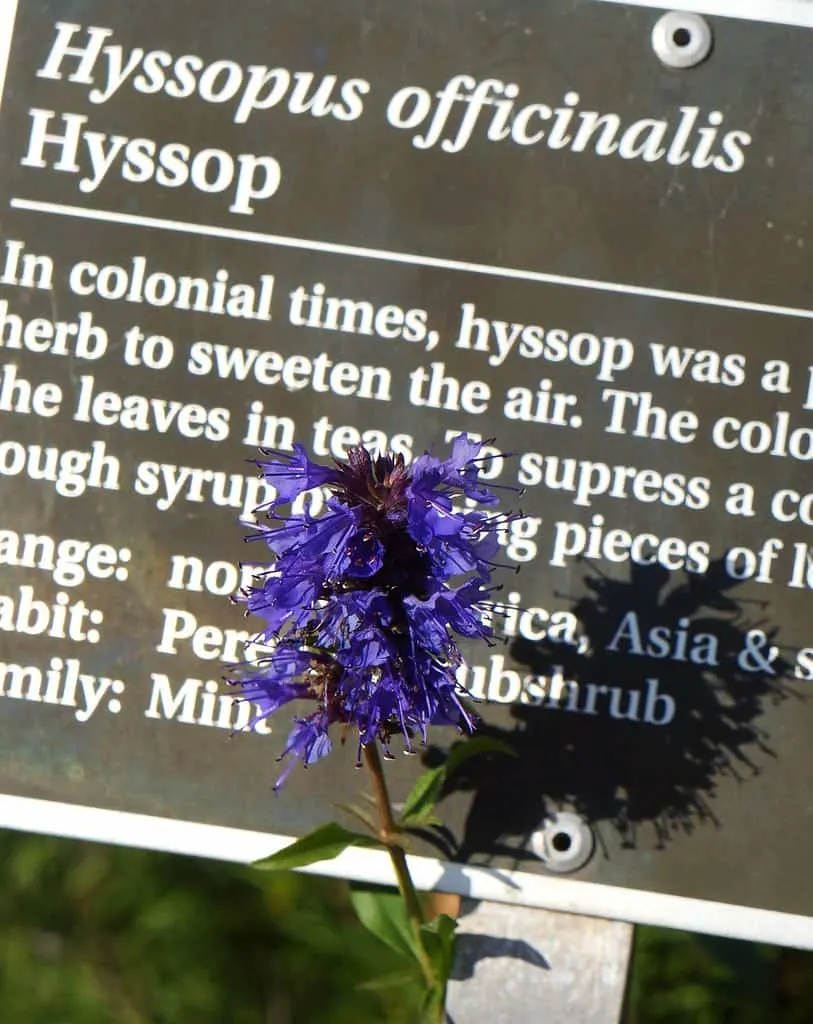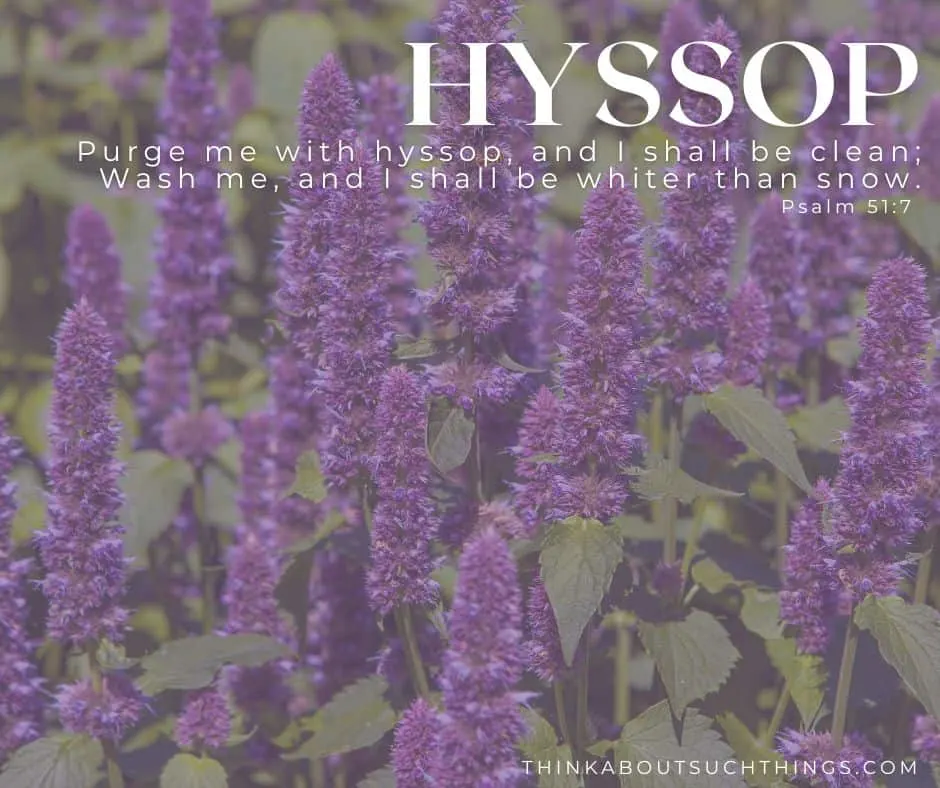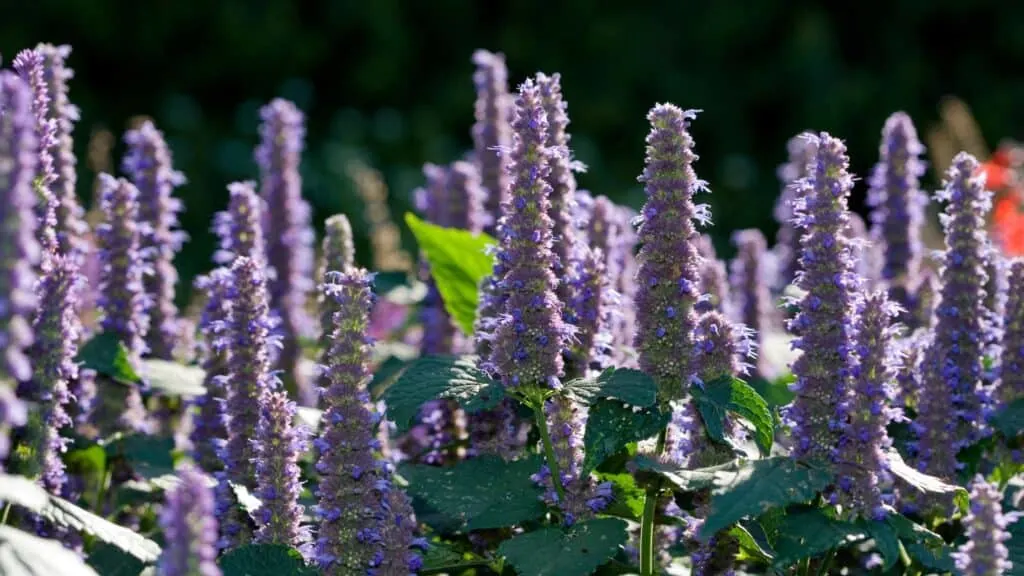In this article, we will explore another plant, and today, it’s on hyssop in the Bible. We will look at the symbolism, meaning, and more. So, grab your Bible, and let’s dig in…
The Bible is full of references to plants and herbs in various contexts. And if you dig deep on some of these plants and flowers, you will be fascinated by what you will learn.
ome of these contexts are literal, but there are also many that contain significant symbolic meanings, and believers can learn much about the heart of God and the relationship we have with Him when we understand these symbolisms.
One such plant is the hyssop. It is mentioned twelve times in the Bible, ten of which occur in the Old Testament.
But what is the hyssop plant, and what does it mean in the Bible? Is there anything we can learn about this flower?

What Is Hyssop?
Hyssop is a herbaceous plant of the genus Hyssopus and is part of the mint family!
It’s native to the Mediterranean, the Middle East, and the region surrounding the Caspian Sea. The plant is known for its aromatic leaves that are used both in cooking and herbal medicine.
In cooking, hyssop is often used as a flavoring agent. Its leaves have a slightly bitter taste and a strong minty aroma, making them perfect for soups, salads, and meat dishes. Hyssop can also be used to flavor liqueurs.
It is also an essential component in herbal medicine as it is known to help with problems in the throat, nose, chest, and ears. Throughout the ages, people have also used its sap as a balm to soothe skin problems.

Scholars are uncertain if the hyssop plant mentioned in the Bible is the same plant we know today, especially since some verses referring to hyssop don’t seem to relate to the modern-day plant.
For example, Jesus was handed a sponge full of sour wine on a hyssop branch while He was on the cross, but modern hyssops don’t usually have branches that are long enough. But some say that hyssop strands bound together could be what they meant by branch.
However, most scholars agree that modern hyssops are at least closely related to the ones mentioned in the Bible.
Hyssop in the Bible
אֵזוֹב ʼêzôwb, ay-zobe’; probably of foreign derivation; hyssop:—hyssop.

According to the Law of First Mention, we can understand more about the Biblical symbolic meaning of something when we look at the context in which it was first mentioned.
So, let’s start by looking at the first occurrence of the word “hyssop” in the Bible, and that is in Exodus 12:22:
“Take a bunch of hyssop and dip it in the blood that is in the basin, and touch the lintel and the two doorposts with the blood that is in the basin. None of you shall go out of the door of his house until the morning.”
This is the scripture where God was about to send the tenth plague upon Egypt. To protect Israel from the curse of the death of the firstborn, God instructed the people to celebrate the first Passover and to paint the blood of the lamb that they sacrificed on the doorposts of their homes.
This would keep the plague from touching the people of Israel.
And interestingly, the tool they had to use to paint the blood on their doorframes and lintels was hyssop.
In a way, the hyssop was used to indicate that these homes were cleansed and the people inside were sanctified, so no curse or death would be allowed to touch them.
Today, we know that the blood of the sacrificial lamb prophesied the suffering and death of Jesus for our salvation.
This means that the hyssop plant symbolically carries a close connection to God’s salvation plan.
Other Hyssop Verses Referring To Cleansing

Most of the other verses in the Bible refer to hyssop in the context of cleansing.
Leviticus 14 mentions hyssop plants five times, but the context is interesting. The chapter is about God telling Moses what the people should do when someone has been healed of leprosy.
The healed leper was to go to the priests and be inspected, after which the priest had to sprinkle the blood of a wild bird on the person using a branch of hyssop.
This indicated that the person was cleansed.
Since leprosy is often used as a metaphor for sin, the fact that hyssop plants indicated the cleansing from leprosy also ties it in with our salvation. Pretty interesting if you ask me!
Numbers 19:6 and 18 also indicate how the people were to use hyssop in purification rituals, especially to purify a room or tent where someone had died.
And the priest shall take cedar wood and hyssop and scarlet, and cast them into the midst of the fire burning the heifer. – Numbers 19:6
A clean person shall take hyssop and dip it in the water, sprinkle it on the tent, on all the vessels, on the persons who were there, or on the one who touched a bone, the slain, the dead, or a grave. – Numbers 19:18
Since the death of a person in a particular room made the room impure, as well as anyone who touched the deceased person, hyssop was used to cleanse the room and the people.
Psalm 51 is known as David’s Psalm of Repentance. David is crying out for God’s forgiveness after his sin with Bathsheba and her husband. It’s in this context that we find verse 7:
“Purge me with hyssop, and I shall be clean; wash me, and I shall be whiter than snow.”
David is asking God to purge him and clean him, once again associating the hyssop with cleansing and sanctification.
Hebrews 9 is a recap of how Moses cleansed the people, the altar, and the Tabernacle. Here the author is again referring to the use of hyssop in cleansing and sanctification, which he later brings into the context of Jesus.
So, how does Jesus fit in with the symbol of the hyssop?
Jesus And The Hyssop Branch
By now, we know that hyssop symbolizes cleansing and sanctification.
We’ve also seen how the Israelites used hyssop to place the blood of the lamb on their doorposts to keep the curse (death) from entering their homes.
And we also know that the blood of the lamb is symbolic of the blood of Jesus, which He gave to keep the curse of death from claiming us, the believers.
It’s interesting, then, that John 19:29 says the following:
“A jar full of sour wine stood there, so they put a sponge full of the sour wine on a hyssop branch and held it to His mouth.”
Jesus was hanging on the cross, about to give His life as the true sacrificial Lamb that all the symbols have been pointing to.
At that moment, He was carrying all the sins of the world and becoming the curse for us. The blood of the Innocent was being spilled for the cleansing and sanctification of all humanity.
And, to emphasize this point and bring all the prophecies and symbolism from centuries of traditions to a close,
He drank sour wine from a sponge offered to Him on the tip of a hyssop branch just before breathing His last breath.
It always amazes me how God ties things together like that!
Do We Need Hyssop For Cleansing?
No, we don’t need to use hyssop for cleansing. Jesus did that, and in His Name, we have all the cleansing that we will ever need! Praise God!!
There’s no need to plant and grow hyssop in our gardens to cleanse our bodies, homes, or anything else. That was under the law of Moses.
But hyssop is still a powerful symbol.
We can use it for its symbolic value as long as we recognize that the purification power is not in the hyssop, which is simply a plant.
As the blood of lambs was never intended to be enough to blot out the sins of the people but were symbols of the one True Lamb which was to come, the hyssop is a symbol of the purification that Jesus bought for us.
To wrap things up…
Hyssop is mentioned twelve times in the Bible.
Apart from the verse that refers to Solomon’s wisdom, every other mention of the word is in the context of cleansing and sanctification.
From God’s instructions to Moses on how lepers and homes were to be purified and cleansed to David’s outcry to be forgiven, hyssop always played an important symbolic role.
But all of these pointed to the one complete cleansing God gave the world through His Son, Jesus Christ.
We can all be cleansed and saved through His suffering, death, and resurrection. And, best of all, we don’t have to sacrifice any animals or sprinkle the blood with hyssop to earn it – it’s ours when we accept and receive His sacrifice.
When we read about hyssop in the Bible, we can rejoice in the knowledge that God has cleansed us in every way so we can stand blameless before Him.

Melissa is a passionate minister, speaker and an ongoing learner of the Bible. She has been involved in church and vocational ministry for over 18 years. And is the founder of Think About Such Things. She has the heart to equip the saints by helping them get into the Word of God and fall more in love with Jesus. She also enjoys family, cooking, and reading.
She has spoken in churches in California, Oregon, Texas, and Mexico and has been featured in Guidepost Magazine and All Recipes Magazine. Read More…
